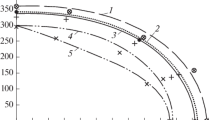Abstract
The development of models relating the fatigue strength of materials to their static strength and plasticity is considered. Statistical strength theories were developed to describe the results of fatigue tests and to predict the strength of machine components with variable loads. Experiments show that the strength of materials depends significantly on structural defects, and the limiting stress is a statistical quantity.
Similar content being viewed by others
References
Agamirov, L.V., Development of statistical evaluation of the fatigue characteristics of materials and indicators of reliability of structural elements of aviation equipment, Extended Abstract of Doctoral (Tech.) Dissertation, Moscow: Moscow Aviat. Inst., 1994.
Stepnov, M.N., Chernyshev, S.L., Kovalev, I.E., and Zinin, A.V., Kharakteristika soprotivleniya ustalosti. Raschetnye metody otsenki (Characteristics of Fatigue Resistance: Estimation Methods), Moscow: Tekhnol. Mashinostr., 2010.
Ivanova, V.S. and Terent’ev, V.F., Priroda ustalosti metallov (Nature of Metal Fatigue), Moscow: Metallurgiya, 1975.
Afanas’ev, N.N., Statistical theory of fatigue resistance of metals, Zh. Tekh. Fiz., 1940, vol. 10, no. 19, pp. 1553–1568.
Afanas’ev, N.N., Statisticheskaya teoriya ustalostnoi prochnosti metallov (Statistical Theory of Fatigue Strength of Metals), Kiev: Akad. Nauk UkrSSR, 1953.
Volkov, S.D., Statisticheskaya teoriya prochnosti (Statistical Theory of Strength), Moscow: Mashgiz, 1960.
Volkov, S.D., The theory of macrocraks: Part 1. The simplest models, Probl. Prochn., 1981, no. 2, pp. 44–48.
Volkov, S.D., Dubrovina, G.I., and Sokovnin, Yu.P., Stability of material resistance in fracture mechanics, Probl. Prochn., 1978, no. 6, pp. 65–69.
Konovalov, L.V., Engineering taking for account fatigue as required condition for creation of efficient mechanical systems, Vestn. Mashinostr., 1993, no. 3, pp. 3–11.
Ivanova, V.S. and Terent’ev, V.F., Priroda ustalosti metallov (Nature of Metal Fatigue), Moscow: Metallurgiya, 1975.
Selikhov, A.F. and Chizhov, V.M., Veroyatnostnye metody v raschetakh prochnosti samoleta (Probabilistic Calculations of an Aircraft Strength), Moscow: Mashinostroenie, 1987.
Serensen, S.V., Fatigue of materials and construction elements, in Izbrannye trudy (Selected Research Works), Kiev: Naukova Dumka, 1985.
Stepnov, M.N., Statisticheskie metody obrabotki rezul’tatov mekhanicheskikh ispytanii: spravochnik (Statistical Analysis of the Results of Mechanical Tests: Handbook), Moscow: Mashinostroenie, 1985.
Surkov, A.I., Probabilistic evaluation of strength at variable loads along the median endurance limits of different-size samples, Probl. Prochn., 1982, no. 12, pp. 42–50.
Basyuk, S.T., Evteev, F.I., and Kovalev, S.I., Expert system for the engineering and manufacture of aircraft wheels, Vopr. Aviats. Nauki Tekh., Ser. Tekhnol. Legkikh Splavov, 1987, no. 11, pp. 58–61.
Basyuk, S.T., Ob”emnaya shtampovka zagotovok iz legkikh splavov na gidravlicheskikh pressakh (Large Pressing of Light-Alloy Billets on Hydraulic Presses), Moscow: Sport i Kul’tura–2000, 2011.
Basyuk, S.T., Intensifikatsiya deformatsii sdviga pri izgotovlenii polufabrikatov (Intensive Shift Deformation in Production of Semi-Finished Products), Moscow: Sport i Kul’tura–2000, 2010.
Makhutov, N.A., Deformatsionnye kriterii razrusheniya i raschet elementov konstruktsii na prochnost’ (Deformation Criteria of Destruction and Calculation of Construction Elements for Strength), Moscow: Mashinostroenie, 1981.
Lisin, A.N., Evaluation of the characteristics of fatigue resistance and the survivability of vehicle wheels, Extended Abstract of Doctoral (Tech.) Dissertation, Moscow: Russ. State Technol. Univ., 2012.
Mozalev, V.V. and Lisin, A.N., The application of statistical strength theories in the function analysis of distribution curve of fatigue, Aviakosm. Tekh. Tekhnol., 2014, no. 4, pp. 41–45.
Bogdanoff, J.L. and Kozin, F., Probabilistic Models of Cumulative Damage, New York: Wiley, 1985.
Khazanov, I.I., Agafonov, Yu.A., and Mozalev, V.V., Optimization of routine tests during operation of aviation wheels by technical state, Tr. Gos. Nauchno-Issled. Inst. Grazhd. Aviats., 1980, no. 183, pp. 17–22.
Author information
Authors and Affiliations
Corresponding author
Additional information
Original Russian Text © A.N. Lisin, I.I. Nabokov, V.V. Mozalev, 2017, published in Vestnik Mashinostroeniya, 2017, No. 2, pp. 46–50.
About this article
Cite this article
Lisin, A.N., Nabokov, I.I. & Mozalev, V.V. Predicting the fatigue strength of structural elements. Russ. Engin. Res. 37, 388–392 (2017). https://doi.org/10.3103/S1068798X17050161
Published:
Issue Date:
DOI: https://doi.org/10.3103/S1068798X17050161




